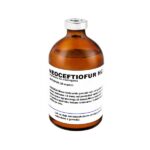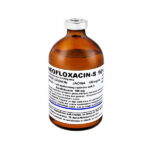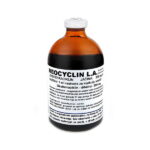Description
NEOTULATHROMYCIN (CURRENTLY IN REGISTRATION PROCESS)
COMPOSITION:
Active substance
Tulathromycin 100 miligrams per mililitre
Excipients:
Monothioglycerol
Propylene glycol
Hydrochloric acid
Sodium hydroxide
Water for injection
INDICATION
Cattle
Treatment and metaphylaxis of bovine respiratory disease (BRD) associated with Mannheimia haemolytica, Pasteurella multocida, Histophilus somni and Mycoplasma bovis sensitive to tulathromycin. The presence of the disease in the herd should be established before metaphylactic treatment. Treatment of infectious bovine keratoconjunctivitis (IBK) associated with Moraxella bovis sensitive to tulathromycin.
Pigs
Treatment and metaphylaxis of swine respiratory disease (SRD) associated with Actinobacillus pleuropneumoniae, Pasteurella multocida, Mycoplasma hyopneumoniae, Haemophilus parasuis and Bordetella bronchiseptica sensitive to tulathromycin. The presence of the disease in the herd should be established before metaphylactic treatment. TULATHROMYCIN should only be used if pigs are expected to develop the disease within 2–3 days.
Sheep
Treatment of the early stages of infectious pododermatitis (foot rot) associated with virulent Dichelobacter nodosus requiring systemic treatment.
CONTRAINDICATION
Do not use in case of hypersensitivity of the target animals to macrolide antibiotics.
Do not use simultaneously with other macrolides or lincosamides (see section 4.8).
Do not use in lactating animals producing milk for human consumption.
Do not use in pregnant animals, which are intended to produce milk for human consumption, within 2 months of expected parturition.
TARGET SPECIES
Cattle, pigs, and sheep
DOSAGE FOR EACH SPECIES, ROUTE(S) AND METHOD OF ADMINISTRATION
Cattle (treatment and metaphylaxis)
2.5 mg tulathromycin/kg bodyweight (equivalent to 1 ml/40 kg bodyweight).A single subcutaneous injection. For treatment of cattle over 300 kg bodyweight, divide the dose so that no more than 7.5 ml are injected at one site.
Pigs
2.5 mg tulathromycin/kg bodyweight (equivalent to 1 ml/40 kg bodyweight). A single intramuscular injection in the neck. For treatment of pigs over 80 kg bodyweight, divide the dose so that no more than 2 ml are injected at one site.
Sheep
2.5 mg tulathromycin/kg bodyweight (equivalent to 1 ml/40 kg bodyweight). A single intramuscular injection in the neck.
ADVICE ON CORRECT ADMINISTRATION
It is recommended to treat animals in the early stages of the disease and to evaluate the response to treatment within 48 hours after injection. If clinical signs of respiratory disease persist or increase, or if relapse occurs, treatment should be changed, using another antibiotic, and continued until clinical signs have resolved. To ensure correct dosage bodyweight should be determined as accurately as possible to avoid underdosing. For multiple vial entry, an aspirating needle or multi-dose syringe is recommended to avoid excessive broaching of the stopper
WITHDRAWAL PERIOD
Cattle (meat and offal): 22 days.
Pigs (meat and offal): 13 days.
Sheep (meat and offal): 16 days.
Not authorised for use in lactating animals producing milk for human consumption.
Do not use in pregnant animals, which are intended to produce milk for human consumption, within 2 months of expected parturition.
SPECIAL STORAGE PRECAUTIONS
Keep the bottle in the outer carton in order to protect from light.
Do not store above 25°C.
Keep out of the sight and reach of children.
Shelf life after first opening the container: 28 days.
SPECIAL WARNING(S)
Special warnings for each target species
Special warnings for sheep:
The efficacy of antimicrobial treatment of foot rot might be reduced by other factors, such as wet environmental conditions, as well as inappropriate farm management. Treatment of foot rot should therefore be undertaken along with other flock management tools, for example providing dry environment. 37 Antibiotic treatment of benign foot rot is not considered appropriate. Draxxin showed limited efficacy in sheep with severe clinical signs or chronic foot rot, and should therefore only be given at an early stage of foot rot.
Special precautions for use in animals
Use of the product should be based on susceptibility testing of the bacteria isolated from the animal. If this is not possible, therapy should be based on local (regional, farm level) epidemiological information about susceptibility of the target bacteria. Official, national and regional antimicrobial policies should be taken into account when the product is used. If a hypersensitivity reaction occurs appropriate treatment should be administered without delay.
Use during pregnancy/ lactation
Laboratory studies in rats and rabbits have not produced any evidence of teratogenic, foetotoxic or maternotoxic effects. The safety of the veterinary medicinal product has not been established during pregnancy and lactation. Use only according to the benefit/risk assessment by the responsible veterinarian.
Interaction with other medicinal products and other forms of interaction
Do not administer simultaneously with antimicrobials with a similar mode of action such as other macrolides or lincosamides.
Overdose (symptoms, emergency procedures, antidotes), if necessary
In cattle at dosages of three, five or ten times the recommended dose, transient signs attributed to injection site discomfort were observed and included restlessness, head-shaking, pawing the ground, and brief decrease in feed intake. Mild myocardial degeneration has been observed in cattle receiving 5 to 6 times the recommended dose. In young pigs weighing approximately 10 kg given three or five times the therapeutic dose transient signs attributed to injection site discomfort were observed and included excessive vocalisation and restlessness. Lameness was also observed when the hind leg was used as the injection site. In lambs (approx. 6 weeks old), at dosages of three or five times the recommended dose, transient signs attributed to injection site discomfort were observed and included walking backwards, head shaking, rubbing the injection site, lying down and getting up, bleating.
Special precautions to be taken by the person administering the veterinary medicinal product to animals
Tulathromycin is irritating to eyes. In case of accidental eye exposure, flush the eyes immediately with clean water. Tulathromycin may cause sensitisation by skin contact. In case of accidental spillage onto skin, wash the skin immediately with soap and water. Wash hands after use. In case of accidental self-injection, seek medical advice immediately and show the package leaflet or the label to the physician.
Incompatibilites
In the absence of compatibility studies, this veterinary medicinal product must not be mixed with other veterinary medicinal products.
SPECIAL PRECAUTIONS FOR THE DISPOSAL OF UNUSED PRODUCT OR WASTE MATERIALS, IF ANY
Any unused veterinary medicinal product or waste materials derived from such veterinary medicinal products should be disposed of in accordance with local requirements.
Nature and composition of packaging: Type I glass vial with a fluoropolymer coated chlorobutyl stopper and an aluminium overseal.
Conditions or restrictions regarding supply and use: On veterinary prescription only.
ATC-vet code: QJ01FA94





Reviews
There are no reviews yet.